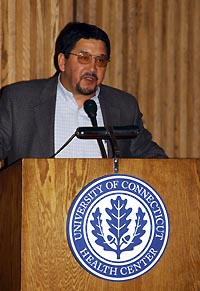|
This is an archived article.
For the latest news, go to the
Advance Homepage
For more archives, go to the Advance Archive/Search Page. | ||
|
Many Substances Can Be Biological Anthrax's success as a biological weapon is well known since its use in this country in a still unsolved attack two years ago that killed five people and sickened at least 17 others. But there are more than 30 biological agents that would be relatively easy to weaponize, biological weapons expert Dr. Kenneth Alibek told an audience interested in preparing for bioterrorism last week. "There is also smallpox, Ebola, plague, and tularemia. The number could go on and on, endlessly," said Alibek.
He should know. Alibek was formerly chief scientist and first deputy chief of the civilian branch of the Soviet Union's offensive biological weapons program, before his defection to this country in 1992. Now he is a professor and executive director of the Center for Biodefense at George Mason University. "Even SARS would be suitable as a biological weapon," said Alibek during his lecture, the third in a series on preparedness for bioterrorism and other disasters, sponsored by the Health Center's Department of Community Medicine and the state Department of Public Health in collaboration with the Centers for Disease Control. Not only is there a wide variety of substances that could be used as weapons, according to Alibek, there is a variety of ways to deploy them: by vector, such as ticks, mites, or mosquitoes; by contaminating food and water supplies; and by aerosol. While vector deployment has not been considered effective for military purposes because of its lack of predictability, it might be viable for a terrorist attack for just that reason, Alibek said. Attack by contamination of food and water sources is considered unlikely because of the large amounts of contaminant that would be required. Aerosol deployment is considered the most effective method, he said. The lack of reliable information and solid knowledge about these agents is a real problem, according to Alibek. During the anthrax attack, misinformation and incorrect assumptions were rampant, he said. Some media reports said the anthrax was definitely weaponized because of the small size of the particles or the electric charge or because it carried a coating. Few of the reports turned out to be accurate, said Alibek. He believes the anthrax attack was launched by somebody in the United States, using relatively primitive technology. "Remember what it felt like during the anthrax scare?" asked Alibek, reminding the audience of the hours they spent listening to television or reading the newspapers to find out the latest news about who was infected or what was contaminated. "We need to develop a completely new science to help us understand these issues," said Alibek, adding that different kinds and sizes of substances have different rates of infection and different people will have varying levels of resistance. "We don't know what kind of medical defense we need to develop," he said, and "we cannot predict what kinds of agents will be used. We need to do much work." |

